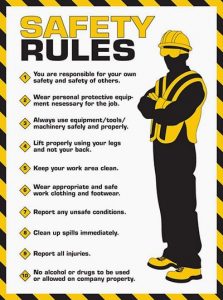Electricity, in this industrial age, is the most crucial component in the entire production process. Not a single computer as well as a majority of other machinery will function if there is no electricity supply. However, electricity is also a very risky commodity. If proper precautions and security measures are not implemented, the outcome may prove disastrous. Numerous reports come from various parts of the world regarding mishaps due to electrical malfunctioning. We take a look at this aspect of industrialisation in this article.
Article by – Arijit Nag
Since ages electricity has long been acknowledged as a serious workplace hazard despite all its advantages. Occupation Safety and Health Assessment (OSHA’s) electrical standards in the US are designed to protect employees exposed to dangers such as electric shock, electrocution, fires, and explosions.
Unfortunately, too many workers are ignorant of the potential electrical hazards existing in their work environment, which makes them more vulnerable to the danger of electrocution. The hazards which are most frequent causes of electrical injuries are the following: contact with power lines, lack of ground-fault protection, path to ground missing or discontinuous, equipment not used in prescribed manner, and improper use of extension and flexible cords.
Working with electricity can be very risky. Engineers, electricians, and other professionals work with electricity directly, including working directly on overhead lines, cable harnesses, and circuit assemblies. Others, such as office workers and sales people, work with electricity indirectly and are also vulnerable to electrical hazards.
According to the US National Fire Protection Association, fire departments across the country responded to an estimated annual average of 47,820 reported home structure fires in the period of 2007-2011– all started by electrical malfunctions. The Electrical Safety Foundation International found that every day, seven children have to be treated for injuries caused by electrical shock.
We are dependent on electricity in our everyday life. It keeps us warm, illuminates our homes, allows us to access all of our entertainment, enables us to eat a warm meal whenever we want and so much more. Electricity has made our lives easier and more enjoyable in so many ways– but that doesn’t mean it comes without its risks – I’ll walk you through a few electrical safety tips that all electricity users should be aware of.
The following five tips will help you enjoy electrical devices and appliances you love while keeping everyone out of harm’s way. A myriad of possible solutions can be applied to reduce or eliminate the risk of injury associated with electrical work. Some of the examples of solutions include the use of insulation, guarding, grounding, electrical protective devices, and safe work practices. Let’s look at some of the measures which can mitigate the hazards related to electricity:
1. Replace or repair damaged power lines
Exposed wiring is dangerous that cannot, or rather should not, be overlooked. If you witness the protective coating on a wire is stripped away, be sure to replace it or cover it with electrical tape as soon as possible.

2. Outlets should not be overloaded
Every outlet in a residential place is designed to deliver a certain amount of electricity. By plugging in too many devices into an outlet at once, there could be a small explosion or a fire. If you have a lot of devices to plug in, use a power strip (an energy saving one, of course!) that can safely accommodate your requirements.
3. Preferably avoid extension cords
Running extension cords through the house can trip residents; this can cause injury and damage to the wire or outlet if it causes the cord to be ripped out of the wall. If you are using extension cords frequently, consider having an electrician install new outlets across the length and breadth of your home.
4. Keep electrical equipment or outlets dry
Water is a good conductor of electricity. Hence, even the slightest exposure to water can lead to injury. Make sure you wipe away any spill to ensure that plugs or outlets don’t get wet.
5. Prevent children from hazards
Toddlers and young children are naturally curious and they love to explore almost everything. Parents of children should put tamper-resistant safety caps on all unused electrical outlets. Additionally, all loose cords should be tidied up and put out of reach to avoid kids tugging on them.
In the Indian context there are several well laid out rules and regulations regarding the usage of electricity.

They are as follows:
i) The Electrical Installations for Medium, High and Extra high voltage must have a danger notice both in English or Hindi and local language of the district with a sign of skulls and bones.
ii) Minimum PPE requirement, Hazards & precautions to be taken, Unauthorized Access Prohibited Signage, Schematic layout of the Electrical Area with emergency Equipment location etc. are to be displayed at the entrance of Electrical Room.
iii) Electrical Shock Chart with instructions in English or Hindi and the local language of the district and where Hindi is the local language, in English and Hindi for the restoration of persons suffering from electric shock have to be affixed in a conspicuous place.
iv) Single-line Diagram has be displayed inside Electrical rooms.
v) The Emergency Action Plan with Emergency contact numbers, Employees’ name who are trained on CPR and first aid to be displayed in Electrical rooms.
vi) First aid boxes, stretchers, Oxypack, gas masks, etc to be made available in electrical rooms or nearby.
vii) The Electrical Installations for high and extra high voltage shall have a running tap of drinking water and Emergency Safety shower with drinking water connection and proper drainage facility. In case of electric burns, the burnt portion should be cooled down using drinking water. In every manned high and extra high voltage sub section, an artificial respirator to be provided.
viii) Cleanliness has to be maintained within the electrical room.
ix) Along with the main exit door, emergency exit door is to be provided and should be in accessible and safe condition in the 415V and above electrical rooms.
Electric shock occurs when the human body becomes a part of an electrical circuit. Primarily, electric shocks can happen in two ways. First, when a person comes in contact with both conductors in a circuit. Secondly, when a person provides a path between an ungrounded conductor and the earth.
At any given point a person may provide a path between the ground and a conducting material that is in contact with an ungrounded conductor. In the context of electricity, high voltage and low voltage are relative terms. In transmission-line terminology, “low voltage” is far higher than the 600 volts. At home, one would not consider 600 volts as low voltage. Even when it is applied to 120-volt circuits, the term low voltage is extremely deceiving. Many people think low voltage means low hazard. However, low voltage does not necessarily mean low hazard, because potential difference is only one factor making up the dangerous effects of electricity.
The extent of injury accompanying an electric shock depends on three factors i.e. the amount of current conducted through the body, the path of the current through the body and the length of time a person is subjected to the current. The amount of the current transmission depends on the potential difference and the resistance. The effects of low current on the human body can range from temporary mild tingling sensation to death.
A severe electrical shock can stop the heart beats or the breathing muscles, or both. The heat effects of the current can also cause severe burns, especially at points where the electricity enters and leaves the human body. Other effects of am electric shock include severe bleeding, breathing difficulty, and ventricular fibrillation. Additionally, one may collide with something or have some other accident as a result of the response to the shock.
Current is the killing factor when an electrical shock occurs. Voltage is important only to the extent that it determines how much current will flow through a given body resistance. The current necessary to operate a 10-watt light bulb is eight to ten times more than the amount required to kill a person. A pressure of 120 volts is enough to produce current which is many times greater than that necessary to cause death in the event of an electric shock. And this makes electricity a dangerous technology which requires a very high standard of safety while dealing with it in any way.
Article by – Arijit nag
Arijit Nag is a freelance journalist who writes on various aspects of the economy and current affairs.
Read more article of Arijit nag



